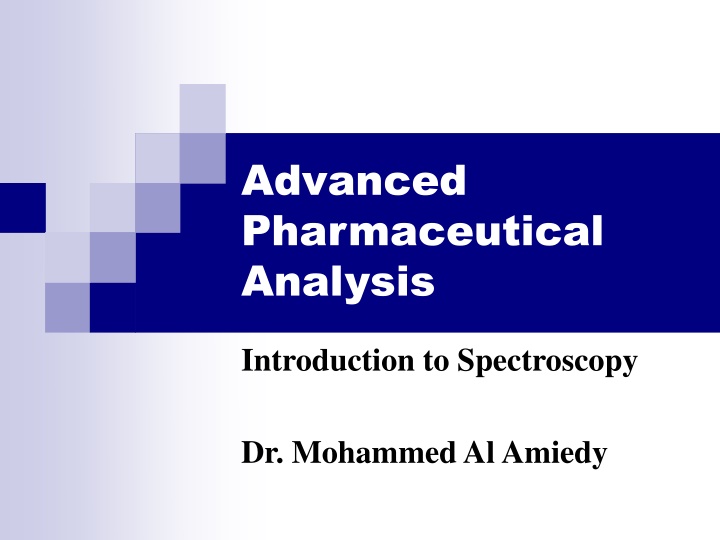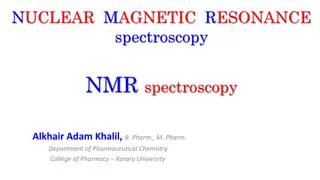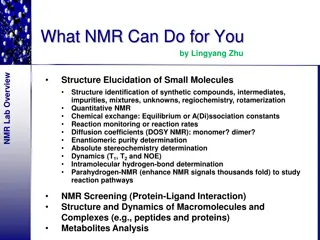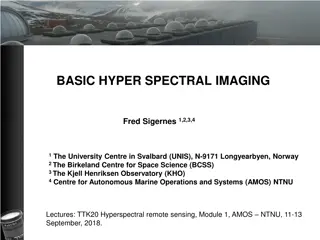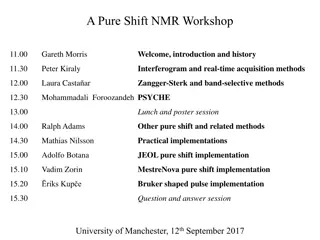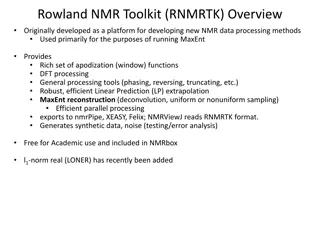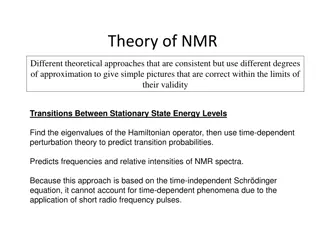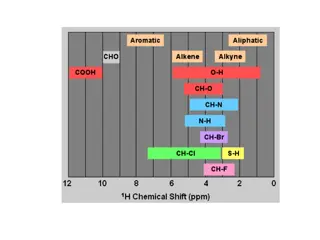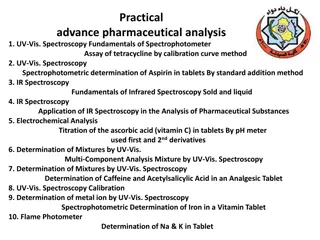Introduction to Chemical Shift in NMR Spectroscopy
Chemical shift is a crucial concept in NMR spectroscopy, defined relative to a reference compound like tetramethylsilane (TMS). It helps characterize signals based on their frequency difference from TMS, aiding in the analysis of organic compounds like benzene. Chemical shifts are reported in parts per million (ppm), indicating a fraction of the spectrometer's operating frequency. Understanding chemical shifts assists in identifying proton environments and distinguishing between different molecules in pharmaceutical analysis.
Download Presentation

Please find below an Image/Link to download the presentation.
The content on the website is provided AS IS for your information and personal use only. It may not be sold, licensed, or shared on other websites without obtaining consent from the author.If you encounter any issues during the download, it is possible that the publisher has removed the file from their server.
You are allowed to download the files provided on this website for personal or commercial use, subject to the condition that they are used lawfully. All files are the property of their respective owners.
The content on the website is provided AS IS for your information and personal use only. It may not be sold, licensed, or shared on other websites without obtaining consent from the author.
E N D
Presentation Transcript
Advanced Pharmaceutical Analysis Introduction to Spectroscopy Dr. Mohammed Al Amiedy
Chemical Shift The location of the signal is called chemical shift ( ), which is defined relative to the frequency of absorption of a reference compound, tetramethylsilane (TMS). Deuterated solvents used for NMR spectroscopy typically contain a small amount of TMS, which produces a signal at a lower frequency than the signals produced by most organic compounds.
Chemical Shift The frequency of each signal is then described as the difference (in hertz) between the resonance frequency of the proton being observed and that of TMS divided by the operating frequency of the spectrometer observed shift from TMS in hertz operating frequency of the instrument in hertz When benzene is analyzed using an NMR spectrometer operating at 300 MHz, the protons of benzene absorb a frequency of rf radiation that is 2181 Hz larger than the frequency of absorption of TMS. The chemical shift of these protons is then calculated as ? =
Chemical Shift 2181 Hz 300 10 6= 7.27 10 6 ? = If a 60-MHz spectrometer is used instead, the protons of benzene absorb a frequency of rf radiation that is 436 Hz larger than the frequency of absorption of TMS. The chemical shift of these protons is then calculated as 436 Hz 60 10 6= 7.27 10 6 the chemical shift of the protons is a constant, regardless of the operating frequency of the spectrometer. ? =
Chemical Shift That is why chemical shifts have been defined in relative terms, rather than absolute terms (hertz). If signals were reported in hertz (the frequency of rf radiation absorbed), then the frequency of absorption would be dependent on the strength of the magnetic field and would not be a constant. the value obtained does not possess any dimensions (hertz divided by hertz gives a dimensionless number).
Chemical Shift The chemical shift for the protons of benzene is reported as 7.27 ppm (parts per million), which are dimensionless units indicating that signals are reported as a fraction of the operating frequency of the spectrometer. For most organic compounds, the signals produced will fall in a range between 0 and 12 ppm. The left side of an NMR spectrum is described as downfield, and the right side of the spectrum is described as upfield. Signals on the left side of the spectrum (downfield) are high- frequency signals because they result from deshielded protons that absorb higher frequencies of rf radiation.
Chemical Shift In contrast, signals on the right side of the spectrum (upfield) are low-frequency signals because they result from shielded protons that absorb lower frequencies of rf radiation.
Chemical Shift Electronegative atoms, such as halogens, withdraw electron density from neighboring atoms This inductive effect causes the protons of the methyl group to be deshielded (surrounded by less electron density), and as a result, the signal produced by these protons is shifted downfield that is, the signal appears at a higher chemical shift than the protons of an alkane. The strength of this effect depends on the electronegativity of the halogen.
Chemical Shift Fluorine is the most electronegative element and therefore produces the strongest effect. When multiple halogens are present, the effect is additive, as can be seen when comparing the following compounds Each chlorine atom adds approximately 2 ppm to the chemical shift of the signal. The inductive effect decreases with distance, as compared the chemical shifts of the protons in 1-chloropropane
Chemical Shift The effect is most significant for the protons at the alpha position. The protons at the beta position are only slightly affected, and the protons at the gamma position are virtually unaffected by the presence of the chlorine atom.
Chemical Shift There are expected chemical shifts for protons that lack neighbouring electronegative atoms. In the absence of inductive effects, the following functional groups will produce signals as These are modified in the presence of neighbouring groups
Chemical Shift The effect on beta protons is generally about one-fifth of the effect on the alpha protons. For example, in an alcohol, the presence of an oxygen atom adds +2.5 ppm to the chemical shift of the alpha protons but adds only +0.5 ppm to the beta protons. Similarly, a carbonyl group adds +1 ppm to the chemical shift of the alpha protons but only +0.2 to the beta protons. These six values, enable us to predict the chemical shifts for the protons in a wide variety of compounds
Chemical Shift The chemical shift of a proton is also sensitive to diamagnetic effects that result from the motion of nearby electrons. Consider what happens when benzene is placed in a strong magnetic field. The magnetic field causes the electrons to circulate, and this flow of electrons creates an induced, local magnetic field. The result is diamagnetic anisotropy, which means that different regions of space are characterized by different magnetic field strengths.
Chemical Shift Locations inside the ring are characterized by a local magnetic field that opposes the external field, while locations outside the ring are characterized by a local magnetic field that adds to the external field. The protons connected to the ring are permanently positioned outside of the ring, and as a result, they experience a stronger magnetic field. These protons experience the external magnetic field plus the local magnetic field. The effect is similar to a deshielding effect, and therefore, the protons are shifted downfield.
Chemical Shift Aromatic protons produce a signal in the neighbourhood of around 7 ppm in an NMR spectrum.
Chemical Shift Ethylbenzene has three different kinds of aromatic protons, producing a complex signal comprised of three overlapping signals just above 7 ppm. A complex signal around 7 ppm is characteristic of compounds with aromatic protons. The methylene group (CH2) in ethylbenzene produces a signal at 2.6 ppm, rather than the expected benchmark value of 1.2 ppm. These protons have been shifted downfield because of their position in the local magnetic field.
Chemical Shift They are not shifted as much as the aromatic protons themselves, because the methylene protons are farther away from the ring, where the induced, local magnetic field is weaker. A similar effect is observed for [14] annulene.
Chemical Shift The protons outside of the ring produce signals at approximately 8 ppm, but in this case, there are four protons positioned inside the ring, where the local magnetic field opposes the external magnetic field. These protons experience the external magnetic field minus the local magnetic field. The effect is similar to a shielding effect, because the protons experience a weaker magnetic field, and therefore, the protons are shifted upfield This effect is quite strong, producing a signal at 1 ppm.
Chemical Shift All bonds exhibit a similar anisotropic effect. That is, electrons circulate under the influence of an external magnetic field, generating a local magnetic field. For each type of bond, the precise location of the nearby protons determines their chemical shift. For example, aldehydic protons produce characteristic signals at approximately 10 ppm. The table below summarizes important chemical shifts. It would be wise to become familiar with these numbers, as they will be required in order to interpret 1H NMR spectra.
